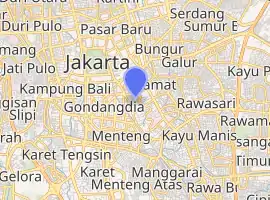Taman Ismail Marzuki
Taman Ismail Marzuki, popularly known as TIM, (English: Ismail Marzuki Park),[1] is an arts, cultural, and science center located at Cikini in Jakarta, Indonesia. Taman Ismail Marzuki complex comprises a number of facilities including six performing arts theaters, cinemas, exhibition hall, gallery, libraries and an archive building.[1]The complex is built on an 9 hectares land area, which was previously a zoo.[2] TIM is named after Ismail Marzuki, one of Indonesia's most influential composers.[3]
| Ismail Marzuki Park | |
|---|---|
| Taman Ismail Marzuki (Indonesian) | |

| |
| Type | Arts and science park |
| Location | Jalan Cikini Raya, Cikini, Jakarta, Indonesia |
| Coordinates | 6°11′21″S 106°50′24″E |
| Created | 10 November 1968 |
The goal to build the complex was to use it as a hub for fine and performing arts, a window into the Indonesia’s diverse ans rich culture. The complex was previously known as Jakarta Arts Center. Management of TIM was handed to the Jakarta Arts Council, while operations are funded by rental fees for the facilities and subsidies from the Jakarta city administration.
History
Inaugurated by Jakarta Governor Ali Sadikin, on 10 November 1968, the 90 meter square cultural center was built on the former Taman Raden Saleh, a public park established and owned by Raden Saleh, who was a famous Indonesian painter during the colonial Dutch East Indies era. Taman Raden Saleh was previously Jakarta's zoo and a public park, before the being moved to Ragunan Zoo. Taman Raden Saleh previously hosted a Greyhound racing arena, a cinema, a Garden Hall and a podium.
The Jakarta administration has undertaken revitalization project which would be conducted in stages for TIM with an estimated cost of US$125 million, and expected to be completed by 2021.[4] The revitalization includes improving the interiors and other facilities of TIM, including the planetarium, as well as construct a library and a mosque to replace the existing ones. A new movie theater is to be built to replace the Cinema XXI movie theater that shut down.[5]
Infrastructure and facilities in the complex
Within the complex there are also educational institutions such as the Jakarta Arts Institute (IKJ), the HB Jassin Literary Documentation Center and Jakarta Planetarium. There is also a large food-court within the complex. Cultural performances often take place in this cultural center, including dance, drama and music performances, poetry reading, sculpture, painting and art exhibitions, and film festival screenings.
- Graha Bhakti Budaya, a performing art hall with an 800-seat capacity, 600 on the ground floor and 200 on the balcony. The stage measures 15m x 10m x 6m. This air conditioned hall is equipped with lighting, acoustic technology and sound systems; and stages musical concerts, performing arts such as drama, traditional or contemporary dances, and also film screenings.
- Galeri Cipta I, II and III, are galleries housing fine arts, paintings and sculpture exhibitions, art discussions, seminars, and short film screenings.[6] These galleries can contain 80 paintings and 20 sculptures.
- Teater Jakarta is a performing art studio which has two theater, the larger one with a capacity of 1200 and the smaller one with capacity of 300 spectators. Theater, music, poetry and seminars are staged here. The stage measures 10m x 5m x 6m. The building equipped with acoustic and lighting systems and is air conditioned.[7]
- Kineforum, a 45-person capacity theater run by the Jakarta Arts Council.
- Teater Halaman or Studio Pertunjukan Seni is an open-air auditorium for experimental art for young artist's theater and for poetry performances.
- Plaza: the courtyard of TIM is sometimes used as additional space to stage outdoor performing that can accommodate 2,500 spectators.
- Jakarta Arts Institute (IKJ), HB Jassin Literary Documentation Center and Jakarta Planetarium also located within the complex.
Cited works
- Merrillees, Scott (2015). Jakarta: Portraits of a Capital 1950-1980. Jakarta: Equinox Publishing. ISBN 9786028397308.CS1 maint: ref=harv (link)
References
- Merrillees 2015, p. 131.
- "Will the Taman Ismail Marzuki facelift erase its mythology". The Jakarta Post. Retrieved 27 February 2019.
- "Taman Ismail Marzuki, Pusat Kesenian untuk Mengenang Sang Komposer". Kompas. Retrieved 19 August 2018.
- "TIM revitalization project to break ground on Jakarta's anniversary". The Jakarta Post. Retrieved 31 May 2019.
- "New movie theater planned at Taman Ismail Marzuki". The Jakarta Post. Retrieved 23 August 2019.
- "Taman Ismail Marzuki -- sweet escape in hectic Jakarta". Antara News. Retrieved 19 February 2020.
- "Jakpost guide to Jl. Cikini Raya". The Jakarta Post. Retrieved 18 August 2018.